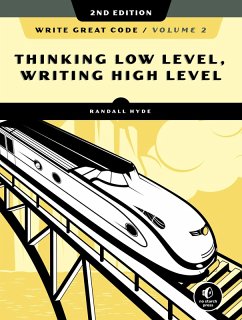Explains how compilers translate high-level language source code (like code written in Python) into low-level machine code (code that the computer can understand) to help readers understand how to produce the best low-level, computer readable machine code. In the beginning, most software was written in assembly, the CPU's low-level language, in order to achieve acceptable performance on relatively slow hardware. Early programmers were sparing in their use of high-level language code, knowing that a high-level language compiler would generate crummy, low-level machine code for their software. Today, however, many programmers write in high-level languages like Python, C/C++/C#, Java, Swift. The result is often sloppy, inefficient code. But you don't need to give up the productivity and portability of high-level languages in order to produce more efficient software. In this second volume of the Write Great Code series, you'll learn: • How to analyze the output of a compiler to verify that your code does, indeed, generate good machine code • The types of machine code statements that compilers typically generate for common control structures, so you can choose the best statements when writing HLL code • Just enough 80x86 and PowerPC assembly language to read compiler output • How compilers convert various constant and variable objects into machine data, and how to use these objects to write faster and shorter programs NEW TO THIS EDITION, COVERAGE OF: • Programming languages like Swift and Java • Code generation on modern 64-bit CPUs • ARM processors on mobile phones and tablets • Stack-based architectures like the Java Virtual Machine • Modern language systems like the Microsoft Common Language Runtime With an understanding of how compilers work, you'll be able to write source code that they can translate into elegant machine code. That understanding starts right here, with Write Great Code, Volume 2: Thinking Low-Level, Writing High-Level.
Dieser Download kann aus rechtlichen Gründen nur mit Rechnungsadresse in A, B, BG, CY, CZ, D, DK, EW, E, FIN, F, GR, HR, H, IRL, I, LT, L, LR, M, NL, PL, P, R, S, SLO, SK ausgeliefert werden.
Praise for the first edition of Write Great Code, Volume 2:
"Set aside some money and buy this book, or get a friend to buy it and get it from them while still in the store. When you get home, read it TWICE so that you master what is in these pages. Then read it again."
DevCity
"Write Great Code Volume 2 exceeds its goal of helping developers pay more attention to application performance when writing applications in high-level languages. This book is a must for any high-level application developer.
Free Software Magazine
"As a high-level-language programmer, if you want to know what's really going on with your programs, you need to spend a little time learning assembly language and you won't find an easier introduction."
DevX
"This is a good book. A very very good book. Frankly, I'm blown away at the quality of writing."
Toronto Ruby User Group
"Set aside some money and buy this book, or get a friend to buy it and get it from them while still in the store. When you get home, read it TWICE so that you master what is in these pages. Then read it again."
DevCity
"Write Great Code Volume 2 exceeds its goal of helping developers pay more attention to application performance when writing applications in high-level languages. This book is a must for any high-level application developer.
Free Software Magazine
"As a high-level-language programmer, if you want to know what's really going on with your programs, you need to spend a little time learning assembly language and you won't find an easier introduction."
DevX
"This is a good book. A very very good book. Frankly, I'm blown away at the quality of writing."
Toronto Ruby User Group

